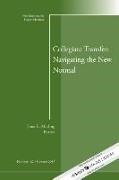Read more
Klappentext Although students have been moving between institutions and attempting to import course credit for many years, current data show that transfer is becoming an increasingly common approach to higher education. This volume is dedicated to exploring this new normal and has been written with a broad constituency in mind. Zusammenfassung Although students have been moving between institutions and attempting to import course credit for many years, current data show that transfer is becoming an increasingly common approach to higher education. This volume is dedicated to exploring this new normal and has been written with a broad constituency in mind. Inhaltsverzeichnis EDITOR'S NOTES 1 Janet L. Marling 1. The Transfer Moment: The Pivotal Partnership Between Community Colleges and Four-Year Institutions in Securing the Nation's College Completion Agenda 5 Stephen J. Handel This chapter addresses transfer from a community college to a fouryear institution, an important pathway for students seeking the bachelor's degree, especially students from underserved groups. The transfer pathway will be an increasingly important source of bachelor's degree holders as colleges and universities strive to meet President Obama's college completion agenda. 2. Deciphering Articulation and State/System Policies and Agreements 17 Trudy H. Bers This chapter provides a brief description of articulation agreements and policies intended to facilitate transfer; examples of institutional partnership, system-level, and statewide approaches; and observations about the characteristics, underlying assumptions, and utility of these agreements and policies. 3. Campus Administrator and Student Perspectives for Improving Transfer Policy and Practice 27 Amy Fann This chapter offers a set of recommendations for two-year and four-year institutions related to the evaluation and implementation of transfer policy and practice. These recommendations were drawn from a major study to investigate the perspectives of students, staff, and administrators. 4. Institutional Practices That Facilitate Bachelor's Degree Completion for Transfer Students 39 Abby Miller This chapter presents findings from two recent Pell Institute studies, which explored the characteristics and experiences of low-income, first-generation community college transfer students in Texas and two-year and four-year institutional approaches to facilitating transfer student degree completion. 5. Building a Transfer-Receptive Culture at Four-Year Institutions 51 Alfred Herrera, Dimpal Jain This chapter reviews a four-year university's role in developing and implementing a transfer-receptive culture. In particular, it focuses on the first element of a transfer-receptive culture by highlighting a series of visits by the chancellor of the University of California, Los Angeles, to community colleges within California. 6. Successful Transitions From Two-Year to Four-Year Institutions 61 Thomas J. Grites This chapter provides an analysis of a set of conditions that transfer students will most likely face in their transition to a new institution. The specific focus is on transfer from two-year to fouryear institutions. 7. The Shared Experiences: Facilitating Successful Transfer of Women and Underrepresented Minorities in STEM Fields 69 Dimitra Lynette Jackson, Soko S. Starobin, Frankie Santos Laanan This chapter addresses critical issues related to the transfer success of women and underrepresented minorities (URMs) in STEM disciplines and will highlight implications for fostering a successful transfer experience for these populations. 8. Navigating the New Normal: Transfer Trends, Issues, and Recommendations 77 Janet L. Marling This chapter establishes the use of data and effective communications as the foundation of comprehensive approaches to facilitating transfer student success and examines transfer ...

